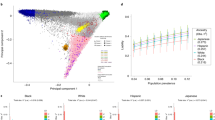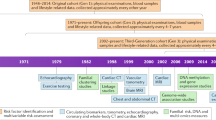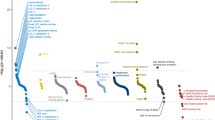Abstract
The Guangzhou Biobank Cohort Study (GBCS, n=30 519, age ⩾50 years) was established to examine the effects of genetic and environmental influences on health problems and chronic disease development. Guangzhou is undergoing massive economic development, but from a baseline that had remained unchanged for millennia. The Cardiovascular Disease Subcohort (GBCS-CVD) consists of 2000 participants who have been intensively phenotyped including a range of surrogate markers of vascular disease, including carotid artery intima-media thickness, cerebral artery stenoses, arterial stiffness, ankle-to-brachial blood pressure index and albuminuria, as well as coagulatory and inflammatory markers. Plasma and leukocytes are stored in liquid nitrogen for future studies. Preliminary demographic data show the female volunteers are younger than the male ones, but present with greater levels of adiposity including central obesity (31 vs 16%). Women had more body fat (33 vs 24%) and associated levels of adipokines. Despite this, body mass index and hip circumferences were similar, which contrasts with Caucasian populations. Men had more physician-diagnosed vascular disease (6.1 vs 2.5%), hypertension (42 vs 34%) and hyperglycaemia (36.6 vs 29.6%) than the women, but were less insulin resistant. In men, smoking (40 vs 2%) and drinking alcohol (67 vs 50%) was more common and they also had lower energy expenditures. The genotype distributions of the 15 typed single nucleotide polymorphisms were all in Hardy–Weinberg equilibrium. This article describes the rationale and methodology for the study. Given the comprehensive characterization of demographic and psychosocial determinants and biochemistry, the study provides a unique platform for multidisciplinary collaboration in a highly dynamic setting.
This is a preview of subscription content, access via your institution
Access options
Subscribe to this journal
Receive 12 digital issues and online access to articles
$119.00 per year
only $9.92 per issue
Buy this article
- Purchase on Springer Link
- Instant access to full article PDF
Prices may be subject to local taxes which are calculated during checkout



Similar content being viewed by others
References
Jiang C, Thomas GN, Lam TH, Schooling CM, Zhang W, Lao X et al. Cohort profile: the Guangzhou Biobank Cohort Study, a Guangzhou-Hong Kong-Birmingham collaboration. Int J Epidemiol 2006; 35: 844–852.
National Bureau of Statistics of P.R. China. China Statistical Yearbook 2007. China Statistics Press: Beijing, 2007.
OECD. Understanding Economic Growth. Palgrave Macmillan: Basingstoke, UK, 2004.
MacFarquhar R, Schoenhals M . Mao's Last Revolution. Harvard University Press: Boston, 2006.
Peng X . Demographic consequences of the Great Leap Forward in China's provinces. Popul Dev Rev 1987; 13: 639–670.
Yin P, Jiang CQ, Cheng KK, Lam TH, Lam KH, Miller MR et al. Passive smoking exposure and risk of COPD among adults in China: the Guangzhou Biobank Cohort Study. Lancet 2007; 370: 751–757.
Thom TJ, Epstein FH . Heart disease, cancer and stroke mortality trends and their interrelations. An international perspective. Circulation 1994; 90: 574–582.
World Health Organization. World Health Statistics Annual 1996. WHO: Geneva, 1998.
Young RP, Thomas GN, Critchley JAJH, Tomlinson B, Woo KS, Sanderson JE . Interethnic differences in coronary heart disease mortality in 25 populations: association with the angiotensin-converting enzyme DD genotype frequency. J Cardiovasc Risk 1998; 5: 303–307.
Woo KS, Chook P, Young RP, Sanderson JE . New risk factors for coronary heart disease in Asia. Int J Cardiol 1997; 62 (Suppl 1): S39–S42.
Diabetes Drafting Group. Prevalence of small vessel and large vessel disease in diabetic patients from 14 centres. The World Health Organization Multinational Study of Vascular Disease in Diabetics. Diabetologia 1985; 28: 615–640.
The Global Lower Extremity Amputation Study Group. Epidemiology of lower extremity amputation in centres in Europe, North America and East Asia. The global lower extremity amputation study group. Br J Surg 2000; 87: 328–337.
Thomas GN, Critchley JAJH, Tomlinson B, Cockram CS, Chan JCN . Peripheral vascular disease in Type 2 diabetic Chinese patients: associations with metabolic indices, concomitant vascular disease and genetic factors. Diabet Med 2003; 20: 988–995.
Wong KS, Huang YN, Gao S, Lam WW, Chan YL, Kay R . Intracranial stenosis in Chinese patients with acute stroke. Neurology 1998; 50: 812–813.
Kay R, Woo J, Kreel L, Wong HY, Teoh T, Nicholls MG . Stroke subtypes among Chinese living in Hong Kong. The Shatin Stroke Registry. Neurology 1992; 42: 985–987.
Feldmann E, Daneault N, Kwan E, Ho KJ, Pessin MS, Lagenberg P et al. Chinese-White differences in the distribution of occlusive cerebrovascular disease. Neurology 1990; 40: 1541–1545.
Wong KS, Huang YN, Gao S, Lam WWM, Chan YL . Cerebrovascular disease among Chinese populations--recent epidemiological and neuroimaging studies. Hong Kong Med J 2001; 7: 50–57.
Wong KS, Li H, Chan YL, Ahuja A, Lam WWM, Wong A et al. Use of transcranial doppler ultrasound to predict outcome in patients with intracranial large-artery occlusive disease. Stroke 2000; 31: 2641–2647.
Wityk RJ, Lehman D, Klag M, Coresh J, Ahn H, Litt B . Race and sex differences in the distribution of cerebral atherosclerosis. Stroke 1996; 27: 1974–1980.
Worth RM, Kato H, Rhoads GG, Syme SL . Epidemiologic studies of coronary heart disease and stroke in Japanese men living in Japan, Hawaii and California: mortality. Am J Epidemiol 1975; 102: 481–490.
International Physical Activity Questionnaire. http://www.ipaqkise/, accessed 15 December 2005.
Livak KJ . Allelic discrimination using fluorogenic probes and the 5 nuclease assay. Genet Anal 1999; 14: 143–149.
Thomas GN, Lin JW, Lam WWM, Tomlinson B, Yeung VTF, Chan JCN et al. Middle cerebral artery stenosis in Type 2 diabetic Chinese patients is associated with conventional risk factors but not with polymorphisms of the renin-angiotensin system genes. Cerebrovasc Dis 2003; 16: 217–223.
Thomas GN, Lin JW, Lam WW, Tomlinson B, Yeung V, Chan JC et al. Albuminuria is a marker of increasing intracranial and extracranial vascular involvement in Type 2 diabetic Chinese patients. Diabetologia 2004; 47: 1528–1534.
Thomas GN, Lin JW, Lam WW, Tomlinson B, Yeung V, Chan JC et al. Increasing severity of cardiovascular risk factors with increasing middle cerebral artery stenotic involvement in Type 2 diabetic Chinese patients with asymptomatic cerebrovascular disease. Diabetes Care 2004; 27: 1121–1126.
Thomas GN, Chook P, Qiao M, Huang XS, Leong HC, Celermajer DS et al. Deleterious impact of ‘high normal’ glucose levels and other metabolic syndrome components on arterial endothelial function and intima-media thickness in apparently healthy Chinese subjects: the CATHAY study. Arterioscler Thromb Vasc Biol 2004; 24: 739–743.
Yamashina A, Tomiyama H, Takeda K, Tsuda H, Arai T, Hirose K et al. Validity, reproducibility, and clinical significance of noninvasive brachial-ankle pulse wave velocity measurement. Hypertens Res 2002; 25: 359–364.
Thomas GN, Ho S-Y, Lam KSL, Janus ED, Hedley AJ, Lam TH et al. Impact of obesity and body fat distribution on cardiovascular risk factors in Hong Kong Chinese. Obes Res 2004; 12: 1805–1813.
Chu JY, Huang W, Kuang SQ, Wang JM, Xu JJ, Chu ZT et al. Genetic relationship of populations in China. Proc Natl Acad Sci USA 1998; 95: 11763–11768.
Gu D, Reynolds K, Duan X, Xin X, Chen J, Wu X et al. Prevalence of diabetes and impaired fasting glucose in the Chinese adult population: International Collaborative Study of Cardiovascular Disease in Asia (InterASIA). Diabetologia 2003; 46: 1190–1198.
Gu D, Reynolds K, Wu X, Chen J, Duan X, Muntner P et al. Prevalence, awareness, treatment, and control of hypertension in China. Hypertension 2002; 40: 920–927.
Grundy SM, Cleeman JI, Daniels SR, Donato KA, Eckel RH, Franklin BA et al. Diagnosis and management of the metabolic syndrome: an American Heart Association/National Heart, Lung, and Blood Institute Scientific Statement. Circulation 2005; 112: 2735–2752.
Acknowledgements
This study was funded by an NSFC/RGC grant (30518001/CO301070202 and HKU720/05). The main cohort study was funded by The University of Hong Kong Foundation for Education and Science, Hong Kong; Guangzhou Public Health Bureau, and Guangzhou Science and Technology Committee, Guangzhou, China; and The University of Birmingham, UK. The Guangzhou Cohort Study-Cardiovascular Disease Subcohort (GBCS-CVD) investigators include: Guangzhou No. 12 Hospital: Jie Ming Lin, Bin Liu, Xiao Jun Yue, Chao Qiang Jiang (Co-PI); The University of Hong Kong: Tai Hing Lam (Co-PI); The Chinese University of Hong Kong: Brian Tomlinson, Ka Sing Wong; The University of Birmingham: Bernard MY Cheung, Shahrad Taheri, Paramjit Gill, Greg YH Lip, Kar Keung Cheng, G Neil Thomas (Co-PI).
Author information
Authors and Affiliations
Corresponding author
Rights and permissions
About this article
Cite this article
Jiang, C., Lam, T., Lin, J. et al. An overview of the Guangzhou Biobank Cohort Study–Cardiovascular Disease Subcohort (GBCS-CVD): a platform for multidisciplinary collaboration. J Hum Hypertens 24, 139–150 (2010). https://doi.org/10.1038/jhh.2009.52
Received:
Revised:
Accepted:
Published:
Issue Date:
DOI: https://doi.org/10.1038/jhh.2009.52
Keywords
This article is cited by
-
Exome-chip association analysis reveals an Asian-specific missense variant in PAX4 associated with type 2 diabetes in Chinese individuals
Diabetologia (2017)
-
White blood cell subsets are associated with carotid intima-media thickness and pulse wave velocity in an older Chinese population: the Guangzhou Biobank Cohort Study
Journal of Human Hypertension (2012)
-
Arterial stiffness and left-ventricular diastolic dysfunction: Guangzhou Biobank Cohort Study-CVD
Journal of Human Hypertension (2011)
-
A single nucleotide polymorphism in APOA5 determines triglyceride levels in Hong Kong and Guangzhou Chinese
European Journal of Human Genetics (2010)
-
Interleukin‐6 Receptor Gene Polymorphism Modulates Interleukin‐6 Levels and the Metabolic Syndrome: GBCS‐CVD
Obesity (2010)



